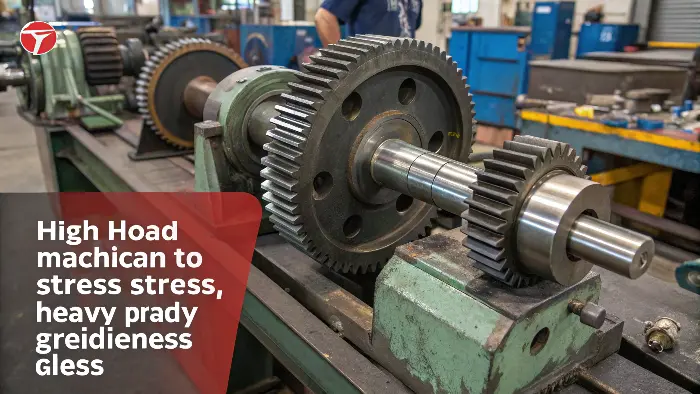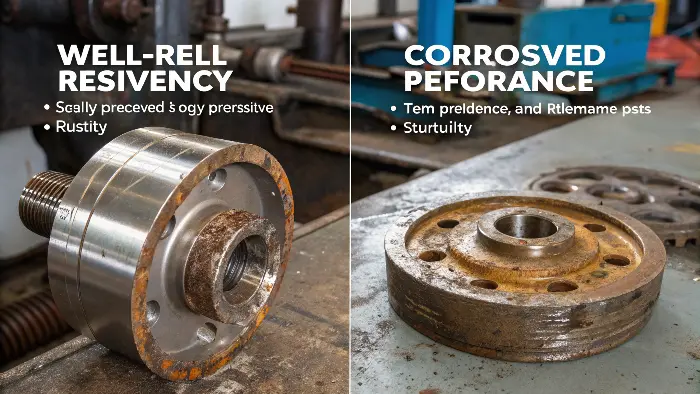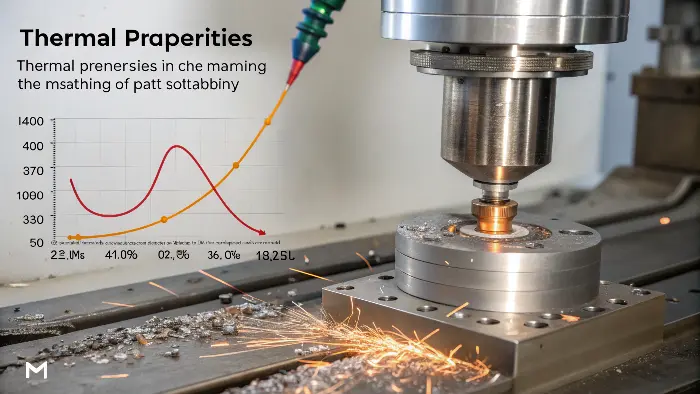Choosing the wrong metal can ruin your CNC project. It leads to machining problems, poor part performance, and wasted money. This is very frustrating.
Understanding key metal properties like machinability, strength, hardness, corrosion resistance, and thermal conductivity is crucial. This knowledge ensures optimal material selection for function, manufacturability, and cost-effectiveness in CNC machining.
As someone who’s spent years in CNC shops and now helps clients globally at QuickCNCs, I’ve seen firsthand how critical material choice is. It’s not just about picking a "strong" metal or the cheapest option. There’s much more to it. The properties of the metal you select directly impact how easily it can be machined, how it performs in its final application, and the overall cost of your project. For engineers like Alex, who designs high-tolerance robotic components in Germany, getting the material right is the first step to success. Let’s break down what you really need to consider to make informed decisions.
What are the Most Important Metal Properties for CNC Machining Success?
Selecting metal without knowing its traits is like navigating without a map. You might get lost, face unexpected issues, and end up with subpar results.
Key properties influencing CNC success are machinability, strength-to-weight ratio, hardness, corrosion resistance, thermal conductivity, and cost. Balancing these ensures optimal project outcomes.
When I first started in a CNC shop, I learned quickly that not all metals are created equal, especially under a cutting tool. Some cut like butter, others fight you every step of the way. At QuickCNCs, we always discuss these properties with our clients.
Key Metal Properties Explained
Understanding these core characteristics helps in selecting the most suitable material.
- Machinability: This refers to how easily a metal can be cut, drilled, milled, or otherwise shaped by machine tools. Good machinability often means faster cycle times, longer tool life, and better surface finishes.
- Strength-to-Weight Ratio: This is vital for applications where high strength is needed without adding too much weight, like in aerospace or performance robotics, which is Alex’s field.
- Hardness: This is the metal’s ability to resist permanent indentation, scratching, or wear. Harder metals are more durable but usually harder to machine.
- Corrosion Resistance: This describes how well a metal withstands degradation from environmental factors like moisture, chemicals, or salt.
- Thermal Conductivity: This is how well a metal conducts heat. It’s important during machining (heat dissipation) and for the part’s end-use if it operates in varying temperatures.
-
Cost: The raw material cost and the cost to machine it are always factors.
Here’s a simple comparison:Property Description Importance for CNC Machining Machinability Ease of cutting and shaping Affects speed, tool life, surface finish, cost Strength-to-Weight Material strength relative to its density Critical for lightweight, high-performance parts Hardness Resistance to wear, abrasion, and indentation Impacts durability and machinability Corrosion Resistance Ability to resist environmental degradation Determines lifespan in specific operating conditions Thermal Conductivity Ability to transfer heat Influences heat buildup during machining, part stability Considering these properties upfront helps avoid problems down the line.
How Does Machinability Impact Your CNC Project’s Cost and Speed?
Poor machinability means slow progress. It wears out tools faster and can drive up the hours needed, blowing your budget and timeline. This causes stress.
Machinability directly influences machining time, tool wear, and surface finish. Metals with good machinability can be processed faster with less tool replacement, reducing overall project costs and lead times.
I’ve seen projects get seriously delayed just because a difficult-to-machine metal was chosen without fully understanding the consequences. Machinability isn’t just a technical term; it has real-world financial and time impacts.
Factors Influencing Machinability
Several things determine how "machinable" a metal is:
- Material Composition: Alloying elements can greatly alter machinability. For example, adding sulfur or lead to steel (like in 12L14 steel) improves it significantly by helping chips break more easily.
- Hardness and Strength: Generally, harder and stronger metals are more difficult to machine. They resist the cutting tool more, generating more heat and force.
- Ductility: Very ductile (soft and gummy) metals, like some coppers or pure aluminum, can be tricky. They might not form clean chips and can build up on the cutting tool.
Impact on CNC Operations
Here’s how machinability plays out:
- Cutting Speeds and Feeds: Easier-to-machine metals allow for faster cutting speeds and feed rates. This means parts get made quicker. Trying to rush a difficult metal often leads to broken tools or bad parts.
- Tool Life: Machining tough metals wears out cutting tools (like end mills and drills) much faster. More tool changes mean more machine downtime and higher tooling costs. I always advise clients like Alex that if a super hard material isn’t absolutely essential, a slightly softer but more machinable grade might save significant money.
- Surface Finish: Some metals naturally produce a better surface finish when machined. Others might require slower speeds, specialized tooling, or secondary finishing operations to get a smooth surface.
- Power Consumption: Harder-to-machine materials require more power from the CNC machine.
Choosing a metal with good machinability for your specific application can be one of the biggest cost-saving decisions you make.When Should You Prioritize Strength and Hardness Over Other Properties?
Sometimes, a part just needs to be tough. If it fails under load or wears out too quickly, the whole product might be compromised. This is a serious concern.
Prioritize strength and hardness for components subjected to high mechanical stresses, loads, impacts, or abrasive wear. This is crucial for structural parts, gears, and wear-resistant surfaces, even if it means higher machining costs.

There are definitely times when you can’t compromise on strength or hardness. For Alex, designing robotic joints that need to withstand continuous movement and significant forces, these properties are often non-negotiable. At QuickCNCs, we often machine high-strength steels or heat-treated aluminum alloys for such demanding applications.Applications Demanding Strength and Hardness
Consider these scenarios:
- Structural Components: Parts that bear significant loads, like support brackets in machinery or framework in vehicles, need high tensile and yield strength.
- Power Transmission Parts: Gears, shafts, and splines must be strong to transmit torque and hard to resist wear from constant contact.
- Wear Surfaces: Components exposed to friction or abrasion, such as bushings, wear plates, or some types of tooling, require high surface hardness.
- Impact Resistance: Parts that might experience sudden shocks or impacts need good toughness, which is related to strength.
Balancing with Manufacturability
The trade-off is clear: stronger, harder metals are usually more difficult and expensive to machine.
- Slower Machining: Cutting speeds and feeds must often be reduced.
- Specialized Tooling: Standard cutting tools may not be effective or wear out too quickly. Carbide or coated tools are often necessary.
- Heat Treatment: Sometimes, a part is machined in a softer state and then heat-treated to achieve the desired hardness. This adds an extra step and cost, and can sometimes cause slight dimensional changes (warping) that need to be accounted for or corrected.
- Material Cost: High-strength alloys can also be more expensive per kilogram.
For example, machining a part from pre-hardened P20 tool steel is much slower than machining it from 6061 aluminum. However, if the application demands P20’s properties, the extra machining effort is justified. We help clients weigh these factors – the need for strength versus the impact on production.Why is Corrosion Resistance a Critical Factor for Long-Term Part Performance?
A part might be perfectly machined and strong, but if it rusts or corrodes quickly in its operating environment, it will fail prematurely. This leads to costly replacements.
Corrosion resistance is vital for parts exposed to moisture, chemicals, or harsh atmospheres. Selecting a metal that resists degradation ensures longevity, reliability, and maintains the part’s structural integrity and appearance.

I’ve seen beautiful parts that look great right off the CNC machine, only to become unusable after a short time in the field because corrosion wasn’t properly considered. For QuickCNCs, especially when we ship parts globally to diverse climates and industries, understanding corrosion is key.Understanding Corrosion
Corrosion is the gradual destruction of materials by chemical or electrochemical reaction with their environment.
- Rusting: The most common form, affecting iron and steel.
- Galvanic Corrosion: Occurs when two dissimilar metals are in contact in a corrosive electrolyte (like saltwater).
- Pitting Corrosion: Localized corrosion that leads to small holes in the metal.
- Chemical Attack: Degradation from exposure to specific chemicals.
Selecting for Corrosion Resistance
Different metals offer varying levels of protection:
- Stainless Steels (e.g., 304, 316): Excellent general corrosion resistance due to their chromium content. 316 is particularly good in marine or chemical environments. Alex might choose this for robotic components used outdoors or in wet processing plants.
- Aluminum Alloys (e.g., 6061, 7075): Form a protective oxide layer. Good for many environments, but can be susceptible to certain chemicals or galvanic corrosion if not properly managed. Anodizing can significantly improve their corrosion resistance.
- Brass and Bronze: Offer good resistance to corrosion from water and some chemicals. Often used in plumbing and marine applications.
- Titanium Alloys: Extremely high corrosion resistance, even in very aggressive environments like seawater or strong acids. However, they are expensive and harder to machine.
Sometimes, a less resistant but cheaper metal can be used if it’s protected by a coating like paint, powder coating, or plating (e.g., zinc plating on steel). This is a common strategy we discuss with clients to balance cost and performance.How Do Thermal Properties of Metals Affect the CNC Machining Process and Part Stability?
Metals expand with heat and conduct it differently. Ignoring this can lead to inaccurate parts or unexpected behavior during machining or in the final assembly.
Thermal expansion can cause dimensional changes during machining and in the final part’s operating environment. Thermal conductivity affects heat dissipation during cutting, influencing tool life and part accuracy.

Heat is an unavoidable part of CNC machining. The friction of the cutting tool against the metal generates heat. How the metal handles this heat, and how it behaves when its own temperature changes, is very important.Key Thermal Properties
Two main thermal properties matter here:
- Coefficient of Thermal Expansion (CTE): This measures how much a material expands or contracts when its temperature changes. Metals with high CTE, like aluminum, will change size more significantly with temperature fluctuations than metals with low CTE, like Invar or some ceramics.
- Thermal Conductivity: This measures how well a material conducts heat away. High thermal conductivity (like in copper or aluminum) helps pull heat away from the cutting zone. Low thermal conductivity (like in stainless steel or titanium) means heat tends to build up right where the tool is cutting.
Impact on Machining and Part Performance
- Machining Accuracy: If a lot of heat builds up in the part during machining, it can expand. If it’s machined to size while hot, it might be undersized once it cools down. This is a big concern for tight tolerance work like Alex’s robotics components. That’s why coolant is so important – not just to lubricate, but to control temperature. For metals with low thermal conductivity, we might use different cutting strategies or more aggressive cooling.
- Tool Life: When heat doesn’t dissipate well from the cutting zone, the cutting tool gets very hot, leading to faster wear or even failure.
- Part Stability in Use: If a part is part of an assembly that experiences temperature swings (like an engine component or outdoor equipment), its CTE is critical. If different parts in an assembly expand at different rates, it can cause stress, warping, or failure of the assembly. I always ask clients about the operating temperature range of their parts for this reason.
Understanding these thermal behaviors helps us at QuickCNCs select appropriate machining parameters and advise clients on material choices that will perform reliably.Conclusion
Understanding metal properties is key for successful CNC machining. It ensures better parts, smoother projects, and avoids costly mistakes, delivering precision and reliability.


